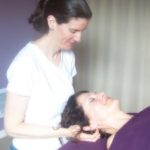
“Your lymphatic system is a forgotten hero.”
~ Anonymous
What Is Lymph?
I’m a huge fan of human anatomy, and the lymphatic system is perhaps my favorite. I actually worked as a massage therapist for 15 years, and lymph drainage was my specialty. Just like there are blood vessels throughout our body, there are also lymphatic vessels. Lymph is the fluid that runs through these vessels. Whereas blood delivers nutrients to our cells, lymph clears cellular waste. It’s essential to our body’s ability to detoxify, and due to modern life, the lymphatic system often needs some extra support. We are exposed to far more toxins than our bodies were designed to handle.
People with autoimmune disease have an additional reason to support their lymphatic system. In addition to clearing cellular waste, lymph is responsible for clearing inflammation. Chronic inflammation puts an extra burden on the lymphatic system and can even damage it long-term. This makes it less efficient, creating a vicious cycle. When this was my career, most of my clients were people with chronic illness. They noticed a huge benefit from supporting their lymphatic system. I have rheumatoid arthritis myself, and “moving my lymph” is a key part of my own self-care.
There are other benefits to moving your lymph as well. Lymph helps us maintain the fluid balance in our body, absorbs dietary fats from our digestive tract, and delivers white blood cells to fight infections. We have approximately 600 lymph nodes along these vessels that monitor and filter this fluid, and produce white blood cells as needed.
1. Self Lymph Drainage
The majority of our lymphatic vessels are located right underneath the skin. They are attached to the skin with small elastic fibers. When you gently stretch the skin with a rhythmic motion, it pumps the lymph through those vessels, releasing stagnation and increasing the flow. The key with this technique is that light touch is much more effective than heavy touch. It’s the opposite of a traditional massage. In fact, forget the word “massage” altogether, because you aren’t gliding your hands across your skin. You’re stretching your skin in a very short, light, repetitive motion. Too much pressure compresses and bypasses the lymphatic vessels.
The video below teaches how to drain the lymph nodes of your neck and head. It can be very helpful during allergy season or anytime you’re experiencing sinus congestion or a headache. It can also be an effective way to boost lymph drainage bodywide. There are over 300 lymph nodes in the neck and head, and the lymphatic system is a contained system. If you increase flow in one area, it helps stimulate flow throughout the system. Note: She mentions contraindications in this video (the times when this technique should be avoided). I’ve listed those at the bottom of this article.
2. Dry Skin Brushing
This is another technique designed to stimulate the lymphatic vessels that lie underneath your skin. Lightly brushing the skin in the direction of the heart can improve the circulation of both the blood and the lymph. It also gently exfoliates your skin, encouraging the production of new skin cells. Similar to the self lymph drainage technique above, your pressure should be gentle. Use a natural bristle brush designed for dry brushing. You can brush slowly, if you want the added benefit of a relaxation response. Or you can brush quickly, if you want to feel energized afterward. Here’s a short tutorial that demonstrates the technique. While she is clothed for the demonstration, you will do this directly on your skin bodywide.
Most tutorials, like the one above, give the general advice to brush toward your heart, and that’s good advice. That is the overall direction of lymphatic flow. However, there are a few exceptions where the path of our lymphatic vessels curves in or out on its way toward the heart. If you want to be very precise with your movements, there are more detailed tutorials available. However, for dry brushing at home, I think general strokes are just fine. This is a simple technique meant to stimulate circulation overall. Professional lymph drainage therapists need to know the lymphatic map precisely. For dry brushing, I don’t believe that’s necessary.
Cautions:
- The contraindications I list at the bottom of this article apply to this technique, along with two additional ones.
- Dry brushing isn’t recommended over any areas with rashes, bumps, cuts, or plaques, because it can cause irritation. If you have an autoimmune skin condition, either avoid areas that are inflamed, or choose one of the other lymphatic techniques instead.
- If you have had lymph nodes removed, consult with a lymphedema specialist before doing this technique. The lymphatic map of your body has changed, and this is a time when I recommend you get personalized recommendations for the direction of your dry brushing strokes.
3. Laughter
The first two techniques I shared above stimulate your superficial lymphatic system (the vessels directly underneath your skin). We also have a deep lymphatic system that flows through our abdomen. Laughter can stimulate those vessels. How wonderful is that? We’ve all heard of the healing power of humor. Laughter is stress-relieving, joy-producing, and it can even help us manage pain. Now, we know it has a fourth benefit: moving our lymph. Make room for laughter in your life. Here’s a list of 25 things that make me laugh, and this video is one of my favorites. Here’s the set-up: If your friends acted like pets.
Final Tips
Drink Plenty of Water: When you stimulate your lymphatic system, you will often feel thirsty afterward. That’s a good sign. You’re detoxifying, and water helps aid your body in flushing the toxins out so they don’t get reabsorbed. Drinking plenty of water each day is one of the easiest ways to support your body’s health.
Professional Lymph Drainage Therapy: At the top of this post, I shared a video tutorial for self lymph drainage. It’s a wonderful home care technique. However, if you have access to a well-trained, professional lymph drainage therapist, it’s truly the best way to move your lymph. The key is finding someone who has this expertise. Many massage therapists advertise “lymphatic massage” who have never been trained in the technique. Instead, they think a light pressure massage is the same thing, and it’s not. Don’t get me wrong – I love massage, and it’s healthy for the body in other ways. But if your goal is to move your lymph, you want a therapist with specialized training. Two respected schools are the The Chikly Institute and Dr. Vodder School, and they both have practitioner directories. See is there’s a skilled practitioner near you.
Contraindications
For home care techniques like these, there’s very little risk of harm. However, there are certain times it’s best to avoid lymphatic work (with the exception of laughter). Don’t stimulate your lymph if you have a fever, acute infection, blood clots, acute inflammation, acute congestive heart failure, acute renal failure, or metastatic cancer.
Disclaimer
There’s always a disclaimer in place on this website, but when an article mentions a therapeutic technique, I feel it needs repeating. I am not a doctor, so this article isn’t medical advice. I’m simply a woman trying to maximize her own health and sharing what I learn along the way. Always consult with your healthcare team when considering new treatments.
You May Also Be Interested In
Credit: image at top of page purchased from iStock.










Thank you! Soooo! Much for sharing this great information. My main problem is following through and doing these things. I’m a African-American woman, 67 yrs old, 5’ll, 325 lbs. I have hereditary lymphedema in my left leg more. And I must follow better ways to take care of myself with my lymphedema.
Hi Erma. I’m so glad you love the article and hope it helps. Lymphedema is challenging! One thing about these techniques is that they feel good to do! That helps with motivation when it feels like a treat rather than a chore. Sending wishes for health and comfort your way.
Hello Eileen: What about the benefits of rebounding — using a type of mini-trampoline–to help one’s lymphatic system?
Hi Eleanor. The majority of the lymphatic vessels are on the surface of the skin and aren’t affected by exercise (including rebounding). That’s why self-lymph drainage and dry brushing are more effective in improving lymphatic circulation. However, rebounding (if tolerated) boosts blood circulation which has its own benefits, and it can improve flow in some of the deeper lymphatic vessels. It just doesn’t match the benefits of superficial lymph drainage. When it comes to lymphatic flow, superficial stimulation is actually more powerful than deep.